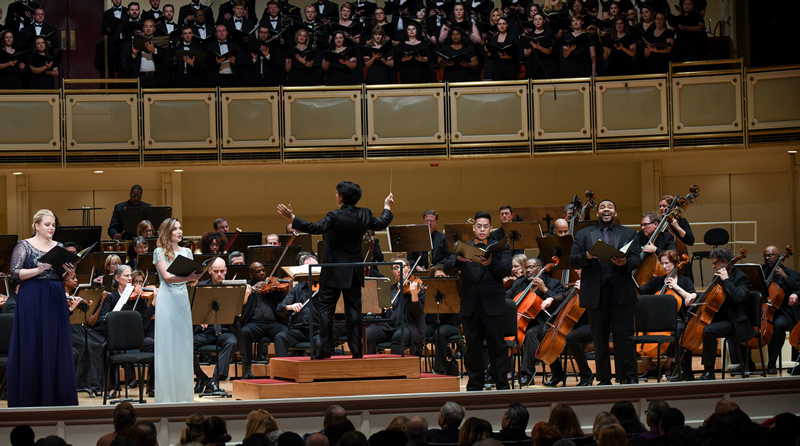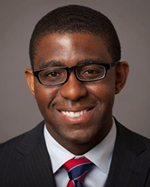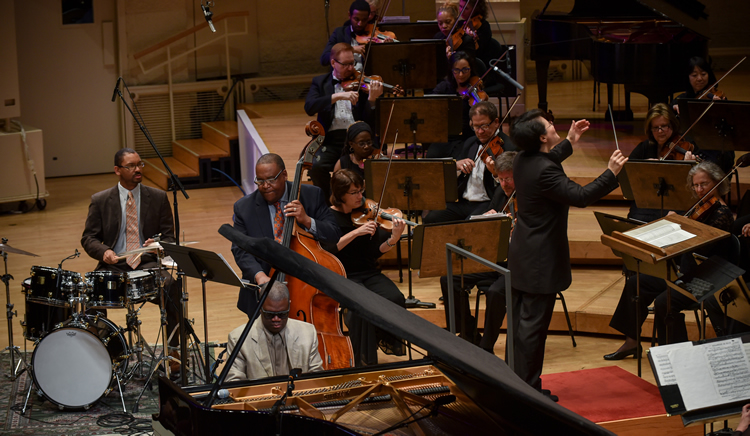Allegro
Finding a New Path Forward
Five useful concepts for a more diverse and inclusive orchestra
Volume 118, No. 1January, 2018

The Chicago Sinfonietta, a professional orchestra covered by an AFM contract, is dedicated to “modeling and promoting diversity, inclusion, and both racial and cultural equity in the arts through the universal language of symphonic music.” Above, the Sinfonietta’s 2017 concert honoring Dr. Martin Luther King, Jr. Photo by Chris Ocken, Ockenphoto.com.
Almost 25 years ago, more than 100 leaders from every facet of the field put forth a bold vision: An American orchestra should be “responsive to and inclusive of its community” and “representative of the cultural and racial diversity of that society.”
Last year, the League of American Orchestras published a study on racial and ethnic diversity in the orchestral field. The results were sobering: in 1980, Blacks and Hispanics comprised just 1.7 percent and 1.8 percent of musicians on stage. Nearly 40 years have passed, and little has changed. Blacks and Hispanics remain significantly underrepresented (1.8 percent and 2.5 percent) on stage as well as in administration, on the podium, and in the boardroom. Disparities in equity and inclusion also remain – unquantified yet palpable and destructive.
As musicians, when we realize an approach is not working, we review key concepts and look for ways to adjust our approach. Below, we pose five key concepts in diversity, equity and inclusion (DEI) that, paired with action steps, may increase the effectiveness of your organizational initiatives.

Shea Scruggs, a former professional oboist, is a strategic initiatives consultant who works closely with senior leadership teams to build mission-driven and data-driven projects.
OBJECTIVITY IS A MYTH
Everyone harbors implicit bias – on race, gender, weight, or practically any characteristic. Implicit (i.e. unconscious) cognitive biases are not inherently bad. Harboring implicit bias doesn’t make you a bad person. They represent “heuristics,” or mental shortcuts, which make it easier for us to get through the 35,000 decisions we make in any given day. Before engaging in the DEI conversation, take a few moments to see for yourself.
Here’s what you can do
Do you have three minutes? Search for the McGurk Effect video on YouTube. Do you still think you can judge unscreened auditions objectively?
Five minutes? Visit the web site of Harvard University’s “Project Implicit” and learn the truth about your social attitudes. Studies reveal that almost 75 percent of Americans who take the Implicit Association Test for race have automatic White preference.
Ready to roll up your sleeves? For even deeper insights, read Anthony Greenwald and Mahzarin Banaji’s book “Blindspot: Hidden Biases of Good People,” or read Nobel Prize winner Daniel Kahneman’s book on heuristics, “Thinking, Fast and Slow.”
Whether it’s about judging auditions or listening to colleagues’ concerns, most people want to be fair and unbiased. The challenge lies in bringing our intentions and actions into alignment. Implicit bias affects all of our perceptions. Nobody is immune. If you are serious about creating an inclusive environment, have the courage to acknowledge your blind spots, and take steps to counteract and preempt them.

MET Orchestra trombonist Weston Sprott is an active educator and advocate/consultant for diversity and inclusion efforts in classical music.
CULTURE MATTERS
Great musicians seek continued professional development. Working diligently in isolation may deliver growth, but reaching our maximum potential often requires seeking constructive criticism from trusted colleagues. Similarly, our orchestra leaders needs to reach beyond their walls and seek advice from firms specializing in assessment of organizational culture.
Is the culture of your working environment healthy? Do the hiring practices of your organization reflect fairness? Is the pay of members in your ensemble influenced by gender or race?
Here’s what your organization can do
Companies like Working IDEAL can conduct diversity assessments and pay-equity audits. Request that your administration reach out to an organization like this.
Firms like WolfBrown, Morgan Lewis Resources, and Sole & Associates have decades of experience helping organizations improve their culture and inclusiveness. Ask your management to consult with such an organization, or have representative groups from your ensemble attend one of their conferences.
Engage in company-wide bias and cultural competency training. Companies like Paradigm provide training in unconscious bias, the mindset of growth, and inclusive leadership. They also consult in the fields of organizational change and inclusion strategies.
Ask your organization to learn about itself. In 2012, the Detroit Symphony Orchestra engaged in a “culture audit.” The results showed that a large percentage of the membership was unclear about the organization’s vision. Many used words like “dysfunctional,” “stressed” or “fractious” to describe the working environment. When the audit was run again in 2015, the results showed an increase of 24 percent in clarity about organizational vision, and people used words like “ambitious,” “innovative” and “diverse” to describe the workplace. This is a fantastic improvement, and it brings us to our next point…
IF YOU CAN’T MEASURE IT, YOU CAN’T FIX IT
What percentages of candidates at your orchestra’s last audition were Black, Hispanic, Asian, men and women? What about candidates for administrative openings? A common refrain among orchestras is, “If we had more qualified candidates of color, we would hire them!” Before assuming such statements are true, verify them with data. Invest in your data gathering culture and infrastructure.
Here’s what you can do
Insist that your orchestra track data about applicants for both performance and administrative positions. The first step towards improvement is to understand your current position.
Review the selection paradigm, and use rubrics when judging candidates to ensure the skills of employees match organizational needs. If your orchestra values education and community outreach, but the audition process only requires proficiency with solos and excerpts, you are not doing justice to your mission.
Survey your job applicants as well as current and departing employees. A tool like Survey Monkey can help provide insights into how applicants felt about the audition process, how current employees feel about the workplace, and why former colleagues chose to depart. Use this data to create practices that are not only fair in reality, but are also perceived as such.
Don’t make decisions in the dark. Lack of data is one of the greatest shortcomings in our industry. A data-driven understanding of an organization’s current position can serve to catalyze change, not just for that organization, but also for the entire field. That’s why we should…

The Chicago Sinfonietta featured the Marcus Roberts Trio in a May 2017 concert called “The Rightness of Rhythm.”
TAKE THIS SERIOUSLY
Approach the issue with the resources and thoughtfulness it deserves. When asked about the investment required to perfect their craft, musicians paint a clear picture, often referring to Malcolm Gladwell’s 10,000-hour rule, ever-increasing costs of instruments, and the large sums of money spent on lessons and education. The development of a professional pedigree requires commitment of both effort and finance. Just as you wouldn’t expect to make musical progress without an investment, don’t assume you can make strides in diversity, equity and inclusion without one either.
Here’s what you should do
Create a budget for DEI initiatives. They say you can tell what an organization values by looking at its budget. With that in mind, don’t begin a DEI initiative without legitimate resources. Conducting surveys, seeking consultation and revising policies requires time and money. Financing allows the work to begin in earnest, and it shows that your organization has skin in the game.
Form groups that are not simply sanctioned to talk but are also authorized to act. A shared vision is a point of departure, not the destination. Avoid the endless cycle of task forces (a/k/a “talk forces”) that spend more time spouting platitudes than producing practical reforms. Reach for tangible gains in workplace policies.
Deputize people who are qualified and committed to the work. Don’t tokenize underrepresented employees by assuming they are more interested or qualified as a result of their ethnicity, or by soliciting their presence but resisting their ideas. Don’t assume diversity, equity and inclusion is not your problem. Rather, recognize that we are all stakeholders in the quest for an inclusive workplace.
Here’s what you shouldn’t do
Don’t wait for an incident to take this work seriously. Don’t treat DEI work as a single-serving event intended to restore calm until the next incident. Instead, make the work a continuing part of organizational culture.
Don’t broaden the scope of your initiative beyond practicality. Reach for the sky and dream big, but keep your immediate focus on pragmatic gains that pay measurable dividends. After all…
This is business
Recognize this is a business issue as well as a moral issue. There are myriad moral arguments for creating an inclusive environment, and talking points about music being a “universal language that brings people together” are nearly cliché. Organizations generally won’t shift simply because it’s the right thing to do. It helps to have a perspective that addresses the bottom line.
Here’s what you need to know
Diversity is a competitive advantage. A 2015 McKinsey study shows that companies in the top quartile for gender diversity are 15 percent more likely to outperform those in the bottom quartile, while ethnically diverse companies are 35 percent more likely to do so. There is a common misconception that diversity is a code word for lowering standards. The statistics reveal the opposite: diversity is a hallmark of successful organizations.
A recent study by the Creative Artists Agency shows, from 2014 to 2016, films with more diverse casts (“Get Out,” “Wonder Woman,” etc.) perform better at the box office than those with less diversity. Furthermore, people of color accounted for nearly half of the ticket-buyers for these films’ opening weekends. If your organization wants more people to purchase tickets and attract a more diverse audience, they should pay attention to this research.
Major funders are interested in supporting DEI initiatives. Making clear that your orchestra values this work and is taking steps to improve provides the opportunity to present to foundations in a more compelling fashion. Hold leadership accountable for fundraising around DEI and moving this mission forward.
It is worth reflecting on why the success of this work is so important. In a nation growing more diverse by the day, the need for orchestras to evolve has never been more urgent. Make no mistake: if the diversity needle continues to move at the pace of the last 25 years, orchestras will soon be facing an existential crisis. In order to address these challenges, we must rethink how our organizations work, and we must be willing to fight for change.
We are rapidly approaching a time when doing things the way they’ve always been done is tantamount to endorsing the inequity, exclusion and lack of diversity that characterize the status quo. The demographic composition of our organizations sends a powerful message to our members, donors, and audiences about what we value, prioritize, and protect. Are we comfortable with that message? Many challenges that stand between orchestras and real diversity, equity and inclusion are within the power of musicians to overcome. From the audition panel to the negotiating table, musicians must have the courage to demand systems that will usher in a bright and sustainable future.
